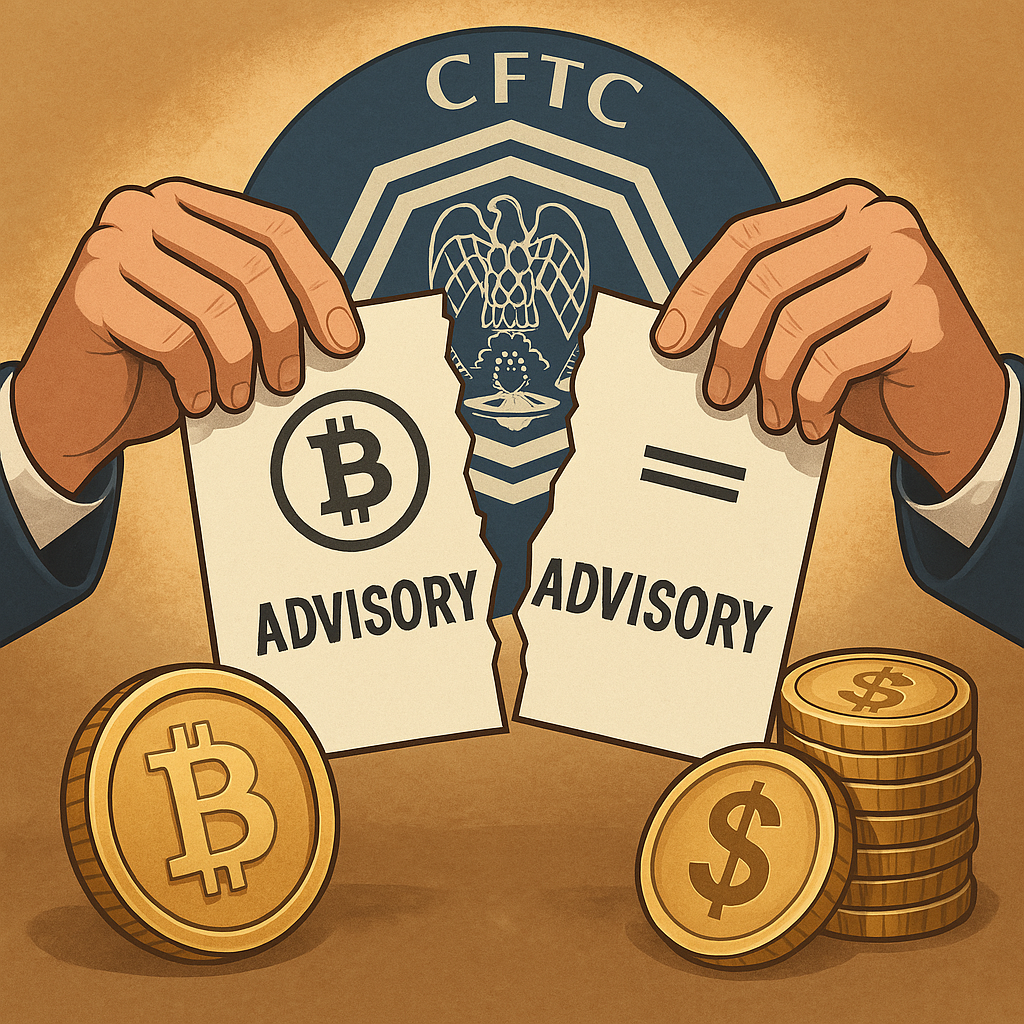Crypto Finance
CFTC’s New Regulatory Stance: A Turning Point For Crypto Derivatives

Introduction
The Commodity Futures Trading Commission (CFTC) has taken a landmark step in its oversight of the digital asset sector by officially withdrawing two previously issued staff advisories related to crypto derivatives trading. This decision, unveiled at the start of April 2025, is a critical moment in the evolution of digital asset regulation in the United States. It signals an intent to treat digital financial instruments—including crypto derivatives—with the same regulatory framework as traditional finance (TradFi), aligning the two worlds more closely than ever before.
Background: The Role Of The CFTC In Crypto Oversight
The CFTC is one of the key U.S. federal agencies overseeing commodity and derivatives markets. With digital assets like Bitcoin and Ethereum increasingly viewed as commodities, the CFTC has long sought to exert jurisdiction over their associated derivatives. Previously, this involved issuing specific advisories that outlined best practices and heightened caution for dealing in crypto-related instruments. These advisories often served as a guidepost for brokers, clearinghouses, and trading platforms engaging in crypto derivatives.
However, as the crypto market matured and regulatory landscapes began to evolve globally, inconsistencies between how digital assets and traditional commodities were treated became a focal point. Industry players repeatedly called for more integrated, uniform rules that would enable fairer competition and smoother market integration.
Why Were The Advisories Removed?
According to official statements from the CFTC and reporting by Digital Watch Observatory and CryptoSlate, the withdrawal of these advisories reflects an acknowledgment that the time has come to fold digital assets more completely into the existing TradFi regulatory framework. By eliminating advisory redundancies specific to crypto, the CFTC is signaling confidence in the maturity of digital asset markets and its regulatory systems’ ability to handle them using traditional structures.
The two advisories in question—issued in 2017 and 2020—had placed stricter scrutiny on crypto derivative contracts, recommending heightened due diligence and operational risk assessments for platforms offering them. These now-rescinded documents emphasized uncertainty around valuation, liquidity, and security in crypto markets.
However, in today’s market environment, where crypto futures and options are routinely traded on major exchanges and regulated venues, such elevated caution has become increasingly outdated. The removal of these documents aligns oversight mechanisms for Bitcoin and Ethereum derivatives with those governing oil, gold, and agricultural commodities.
Implications For The Crypto Industry
Institutional Validation
The CFTC’s move is likely to be viewed as a validation of the crypto industry’s progress. Institutions, both domestic and international, now see clearer regulatory symmetry between digital and traditional assets. This increases institutional confidence and paves the way for further adoption of crypto derivatives by hedge funds, asset managers, and proprietary trading firms.
This is especially true in the wake of rising demand for products like Bitcoin ETFs and Ethereum futures. By reducing perceived regulatory risk, the U.S. opens doors for firms hesitant to dive into crypto markets due to regulatory ambiguity.
Streamlining Compliance and Operations
For exchanges, brokers, and clearing firms, the harmonization of rules simplifies operations. Instead of needing a parallel set of rules and controls for crypto derivatives, companies can use the same compliance protocols they apply to traditional instruments. This reduces costs, shortens onboarding timelines, and facilitates cross-asset strategies.
Furthermore, fintech startups offering hybrid products can now approach regulators with less complexity in their operational blueprints. This may foster innovation and new product development in areas like tokenized derivatives, perpetual swaps, and crypto index futures.
Boost to U.S. Regulatory Reputation
Internationally, the CFTC’s decision reinforces the United States’ standing as a mature and pragmatic regulator in the crypto space. As global regulators debate the proper treatment of digital assets, America’s largest derivatives regulator has made its stance clear: digital assets, when used as derivatives, deserve parity with other tradable commodities.
This could create a ripple effect, encouraging other financial watchdogs around the world to review and update their stance on crypto derivatives. Jurisdictions in Europe and Asia may now look to the U.S. model for inspiration on how to create cohesive, business-friendly crypto oversight.
Potential Risks And Criticisms
While the CFTC’s move has been generally welcomed, some critics argue that the decision may create blind spots if not paired with increased investment in digital asset expertise within the agency. Others worry that treating digital assets as identical to traditional commodities overlooks unique challenges such as extreme volatility, reliance on decentralized technology, and increased susceptibility to hacking.
Consumer protection advocates have also warned that reduced advisory oversight might embolden unqualified or under-resourced firms to enter the space, exposing retail investors to unnecessary risk. Some are calling for the CFTC to clarify how it will ensure that this regulatory parity does not result in oversight gaps or reduced enforcement capacity.
The Bigger Picture: Crypto’s Evolution Into Mainstream Finance
This regulatory update is part of a broader narrative: the merging of digital finance and traditional finance into a cohesive system. We have already seen traditional investment products like ETFs and retirement portfolios integrating crypto assets. Platforms such as CME now offer regulated crypto futures, and custody solutions have reached institutional-grade levels.
The convergence of TradFi and DeFi (decentralized finance) has gained momentum through initiatives such as tokenized treasuries, stablecoin-backed lending, and decentralized derivatives protocols. With regulatory support, these products are poised to transition from niche tools to core financial offerings.
By removing barriers to innovation in the crypto derivatives space, the CFTC may be fueling the next wave of market evolution—one where crypto and traditional assets coexist seamlessly in institutional portfolios and trading desks.
Industry Response And Expert Commentary
Industry leaders and legal experts have largely supported the CFTC’s decision. In interviews published by BeInCrypto and CoinChapter, senior executives from trading firms and compliance consultancies praised the move as “mature,” “pragmatic,” and “timely.” Many see this as part of the regulatory normalization phase, which signals long-term confidence in the digital asset space.
James Miller, head of compliance at a prominent U.S. brokerage, told CryptoSlate, “This move takes away uncertainty and aligns us with global market expectations. It’s a win for regulatory clarity, which ultimately benefits market integrity.”
The sentiment is echoed across major crypto lobbying groups who believe this signals a willingness to support innovation while maintaining market safeguards.
What Comes Next: Regulation By Collaboration
Going forward, the CFTC is expected to work alongside other U.S. regulatory bodies—including the Securities and Exchange Commission (SEC) and the Financial Crimes Enforcement Network (FinCEN)—to ensure that this regulatory integration continues smoothly.
Additionally, more inter-agency cooperation may be necessary to distinguish between crypto tokens classified as securities versus commodities. As the lines between utility tokens, governance tokens, and digital commodities blur, regulators will need agile frameworks to keep pace with technology.
This latest move by the CFTC may also reinvigorate calls for comprehensive crypto legislation in Congress. By demonstrating regulatory leadership and market responsiveness, the CFTC is placing itself at the forefront of policy shaping in the crypto era.
Conclusion
In rescinding its prior crypto-specific advisories, the CFTC has made a clear and consequential statement: digital asset derivatives no longer require separate treatment. They have earned their place alongside traditional financial instruments in the U.S. regulatory architecture.
This shift will likely unlock new capital, spark innovation, and set a precedent for regulators worldwide. It also sends a signal to market participants that the era of crypto as a fringe financial experiment is over. Digital assets are now fully embedded in the fabric of institutional finance—and the rules that govern them are finally catching up.










